Changes in Physicochemical Characteristics and Antioxidant Activities of Dried Shiitake Mushroom in Dry-Moist-Heat Aging Process
Abstract
1. Introduction
2. Materials and Methods
2.1. Materials and Chemicals
2.2. Dried Shiitake Mushroom Preparation
2.3. Dry-Moist-Heat Aging Conditions on Shiitake Mushroom and Extraction Method
2.4. Measurement of Physical Characteristics of Aged Shiitake Mushroom
2.4.1. Color Values
2.4.2. Moisture Content and Water Activity (aw)
2.5. Total Protein Content Measurement
2.6. Amino Acid Profiles Determination
2.7. 5′-Nucleotide Compounds Analysis and Equivalent Umami Concentration
2.8. Total Phenolic Content and Phenolics Determination with HPLC
2.9. Determination of Antioxidant Activity
2.10. Statistical Analysis
3. Result and Discussion
3.1. Physical Characteristics of Aging Shiitake Mushroom
3.2. Total Protein and Free Amino Acids Content of Aging Shiitake Mushrooms
3.3. Compounds of 5′-Nucleotides and Equivalent Umami Content (EUC) of Aged Shiitake Mushroom
3.4. Phenolic Compounds Found in Aged Shiitake Mushroom
3.5. Antioxidant Activities of Aged Shiitake Mushroom
4. Conclusions
Author Contributions
Funding
Data Availability Statement
Acknowledgments
Conflicts of Interest
References
- Data Bridge Market Research. Available online: https://www.databridgemarketresearch.com/infographic/global-shiitake-mushroom-market (accessed on 1 June 2023).
- Yang, X.; Zhang, Y.; Kong, Y.; Zhao, J.; Sun, Y.; Huang, M. Comparative analysis of taste compounds in shiitake mushrooms processed by hot-air drying and freeze drying. Int. J. Food Prop. 2019, 22, 1100–1111. [Google Scholar] [CrossRef]
- Harada-Padermo, S.D.S.; Dias-Faceto, L.S.; Selani, M.M.; Alvim, I.D.; Floh, E.I.S.; Macedo, A.F.; Bogusz, S.; Dias, C.T.D.S.; Conti-Silva, A.C.; Vieira, T.M.F.D.S. Umami Ingredient: Flavor enhancer from shiitake (Lentinula edodes) byproducts. Food Res. Int. 2020, 137, 109540. [Google Scholar] [CrossRef] [PubMed]
- Liu, Q.; Hu, S.; Song, Z.; Cui, X.; Kong, W.; Song, K.; Zhang, Y. Relationship between flavor and energy status in shiitake mushroom (Lentinula edodes) harvested at different developmental stages. J. Food Sci. 2021, 86, 4288–4302. [Google Scholar] [CrossRef] [PubMed]
- Gao, J.; Li, X.; Jia, S.; Zeng, H.; Zheng, B. Structural characterization and antioxidant activity of a glycoprotein isolated from shiitake mushrooms. Food Biosci. 2023, 53, 102608. [Google Scholar] [CrossRef]
- Qin, L.; Gao, J.X.; Xue, J.; Chen, D.; Lin, S.Y.; Dong, X.P.; Zhu, B.W. Changes in aroma profile of shiitake mushroom (Lentinus edodes) during different stages of hot air drying. Foods 2020, 9, 444. [Google Scholar] [CrossRef] [PubMed]
- Chen, D.; Qin, L.; Geng, Y.; Kong, Q.; Wang, S.; Lin, S. The aroma fingerprints and discrimination analysis of shiitake mushrooms from three different drying conditions by GC-IMS, GC-MS and DSA. Foods 2021, 10, 2991. [Google Scholar] [CrossRef]
- Van Ba, H.; Seo, H.W.; Cho, S.H.; Kim, Y.S.; Kim, J.H.; Ham, J.S.; Park, B.-Y.; Pil-Nam, S. Effects of extraction methods of shiitake by-products on their antioxidant and antimicrobial activities in fermented sausages during storage. Food Control 2017, 79, 109–118. [Google Scholar] [CrossRef]
- Ahmad, I.; Arif, M.; Xu, M.; Zhang, J.; Ding, Y.; Lyu, F. Therapeutic values and nutraceutical properties of shiitake mushroom (Lentinula edodes): A review. Trends Food Sci. Technol. 2023, 134, 123–135. [Google Scholar] [CrossRef]
- Somjai, C.; Siriwoharn, T.; Kulprachakarn, K.; Chaipoot, S.; Phongphisutthinant, R.; Wiriyacharee, P. Utilization of Maillard reaction in moist-dry-heating system to enhance physicochemical and antioxidative properties of dried whole longan fruit. Heliyon 2021, 7, e07094. [Google Scholar] [CrossRef]
- Somjai, C.; Siriwoharn, T.; Kulprachakarn, K.; Chaipoot, S.; Phongphisutthinant, R.; Chaiyana, W.; Srinuanpan, S.; Wiriyacharee, P. Effect of drying process and long-term storage on characterization of Longan pulps and their biological aspects: Antioxidant and cholinesterase inhibition activities. LWT 2022, 154, 112692. [Google Scholar] [CrossRef]
- Mau, J.L. The Umami taste of edible and medicinal mushrooms. Int. J. Med. Mushrooms 2005, 7, 119–126. [Google Scholar] [CrossRef]
- Wang, X.; He, X.; Sun, C.; Peng, M.; Zhang, Q.; Brennan, C.S.; Guan, W.; Wang, F.; Zhang, N. Extraction of bound phenolics from shiitake mushrooms (Lentinus edodes) by combined acid and base hydrolysis procedures and analysis of phenolic profiles and antioxidant capacities. Int. J. Food Sci. Technol. 2022, 57, 6613–6620. [Google Scholar] [CrossRef]
- Liaudanskas, M.; Viškelis, P.; Raudonis, R.; Kviklys, D.; Uselis, N.; Janulis, V. Phenolic composition and antioxidant activity of Malus domestica leaves. Sci. World J. 2014, 2014, 306217. [Google Scholar] [CrossRef]
- Rahman, M.S.; Labuza, T.P. Water activity and food preservation. In Handbook of Food Preservation; CRC Press: Boca Raton, FL, USA, 2007; pp. 465–494. [Google Scholar]
- Syamaladevi, R.M.; Tang, J.; Villa-Rojas, R.; Sablani, S.; Carter, B.; Campbell, G. Influence of water activity on thermal resistance of microorganisms in low-moisture foods: A review. Compr. Rev. Food Sci. Food Saf. 2016, 15, 353–370. [Google Scholar] [CrossRef]
- Lewis, M.J.; Bamforth, C.W. Essays in Brewing Science; Springer Science & Business Media: Berlin/Heidelberg, Germany, 2006. [Google Scholar]
- Hu, S.; Feng, X.; Huang, W.; Ibrahim, S.A.; Liu, Y. Effects of drying methods on non-volatile taste components of Stropharia rugoso-annulata mushrooms. LWT 2020, 127, 109428. [Google Scholar] [CrossRef]
- Kantrong, H.; Tansakul, A.; Mittal, G.S. Drying characteristics and quality of shiitake mushroom undergoing microwave-vacuum drying and microwave-vacuum combined with infrared drying. J. Food Sci. Technol. 2014, 51, 3594–3608. [Google Scholar] [CrossRef]
- Piskov, S.; Timchenko, L.; Grimm, W.D.; Rzhepakovsky, I.; Avanesyan, S.; Sizonenko, M.; Kurchenko, V. Effects of various drying methods on some physico-chemical properties and the antioxidant profile and ACE inhibition activity of oyster mushrooms (Pleurotus Ostreatus). Foods 2020, 9, 160. [Google Scholar] [CrossRef]
- Ren, S.; Zheng, E.; Zhao, T.; Hu, S.; Yang, H. Evaluation of physicochemical properties, equivalent umami concentration and antioxidant activity of Coprinus comatus prepared by different drying methods. LWT 2022, 162, 113479. [Google Scholar] [CrossRef]
- Xiao, A.; Ding, C. Effect of electrohydrodynamic (EHD) on drying kinetics and quality characteristics of shiitake mushroom. Foods 2022, 11, 1303. [Google Scholar] [CrossRef]
- Deng, Y.; Wierenga, P.A.; Schols, H.A.; Sforza, S.; Gruppen, H. Effect of Maillard induced glycation on protein hydrolysis by lysine/arginine and non-lysine/arginine specific proteases. Food Hydrocoll. 2017, 69, 210–219. [Google Scholar] [CrossRef]
- Bandyopadhyay, P.; Ghosh, A.K.; Ghosh, C. Recent developments on polyphenol–protein interactions: Effects on tea and coffee taste, antioxidant properties and the digestive system. Food Funct. 2012, 3, 592–605. [Google Scholar] [CrossRef] [PubMed]
- Liu, J.; Yong, H.; Yao, X.; Hu, H.; Yun, D.; Xiao, L. Recent advances in phenolic–protein conjugates: Synthesis, characterization, biological activities and potential applications. RSC Adv. 2019, 9, 35825–35840. [Google Scholar] [CrossRef] [PubMed]
- Zhao, J.; Wang, T.; Zhang, C.; Han, X.; Yan, J.; Gan, B. A comparative analysis of the umami taste of five fresh edible mushrooms by simulating the chemical environment of oral digestion in vitro. LWT 2023, 176, 114522. [Google Scholar] [CrossRef]
- Sun, L.-b.; Zhang, Z.-y.; Xin, G.; Sun, B.-x.; Bao, X.-j.; Wei, Y.-y.; Zhao, X.-M.; Xu, H.-r. Advances in umami taste and aroma of edible mushrooms. Trends Food Sci. Technol. 2020, 96, 176–187. [Google Scholar] [CrossRef]
- Zhang, L.; Dong, X.; Feng, X.; Ibrahim, S.A.; Huang, W.; Liu, Y. Effects of drying process on the volatile and non-volatile flavor compounds of Lentinula edodes. Foods 2021, 10, 2836. [Google Scholar] [CrossRef]
- Hwang, I.S.; Chon, S.Y.; Bang, W.S.; Kim, M.K. Influence of roasting temperatures on the antioxidant properties, β-glucan content, and volatile flavor profiles of shiitake mushroom. Foods 2020, 10, 54. [Google Scholar] [CrossRef]
- Dong, Q.; He, D.; Ni, X.; Zhou, H.; Yang, H. Comparative study on phenolic compounds, triterpenoids, and antioxidant activity of Ganoderma lucidum affected by different drying methods. J. Food Meas. Charact. 2019, 13, 3198–3205. [Google Scholar] [CrossRef]
- Chang, W.-C.; Lin, W.-C.; Wu, S.-C. Optimization of the black garlic processing method and development of black garlic jam using high-pressure processing. Foods 2023, 12, 1584. [Google Scholar] [CrossRef]
- Wang, W.Q.; Bao, Y.H.; Chen, Y. Characteristics and antioxidant activity of water-soluble Maillard reaction products from interactions in a whey protein isolate and sugars system. Food Chem. 2013, 139, 355–361. [Google Scholar] [CrossRef]
- Hamdani, A.M.; Wani, I.A.; Bhat, N.A.; Siddiqi, R.A. Effect of guar gum conjugation on functional, antioxidant and antimicrobial activity of egg white lysozyme. Food Chem. 2018, 240, 1201–1209. [Google Scholar] [CrossRef]
- Nooshkam, M.; Varidi, M.; Verma, D.K. Functional and biological properties of Maillard conjugates and their potential application in medical and food: A review. Food Res. Int. 2020, 131, 109003. [Google Scholar] [CrossRef]
- De Oliveira, F.C.; Coimbra, J.S.; de Oliveira, E.B.; Zuñiga, A.D.; Rojas, E.E. Food Protein-polysaccharide conjugates obtained via the Maillard reaction: A review. Crit. Rev. Food Sci. Nutr. 2016, 56, 1108–1125. [Google Scholar] [CrossRef]
- ALjahdali, N.; Carbonero, F. Impact of Maillard reaction products on nutrition and health: Current knowledge and need to understand their fate in the human digestive system. Crit. Rev. Food Sci. Nutr. 2019, 59, 474–487. [Google Scholar] [CrossRef]
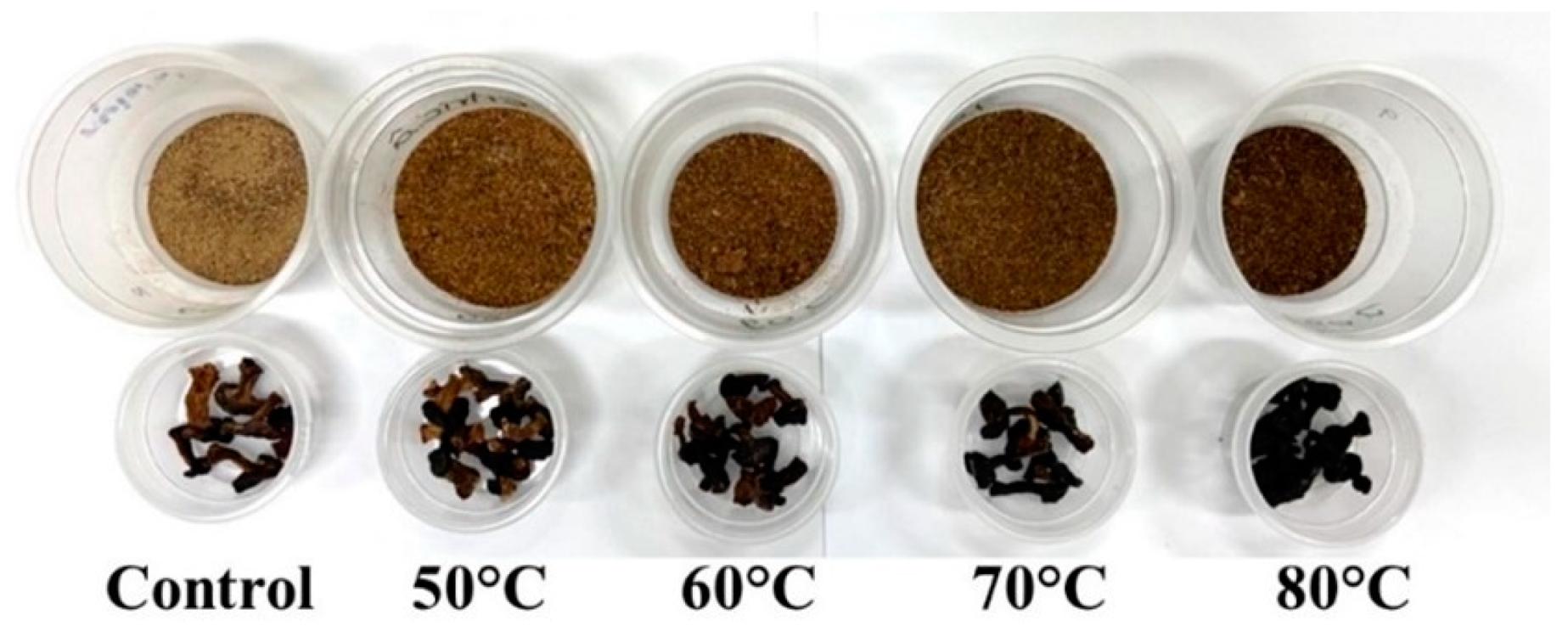
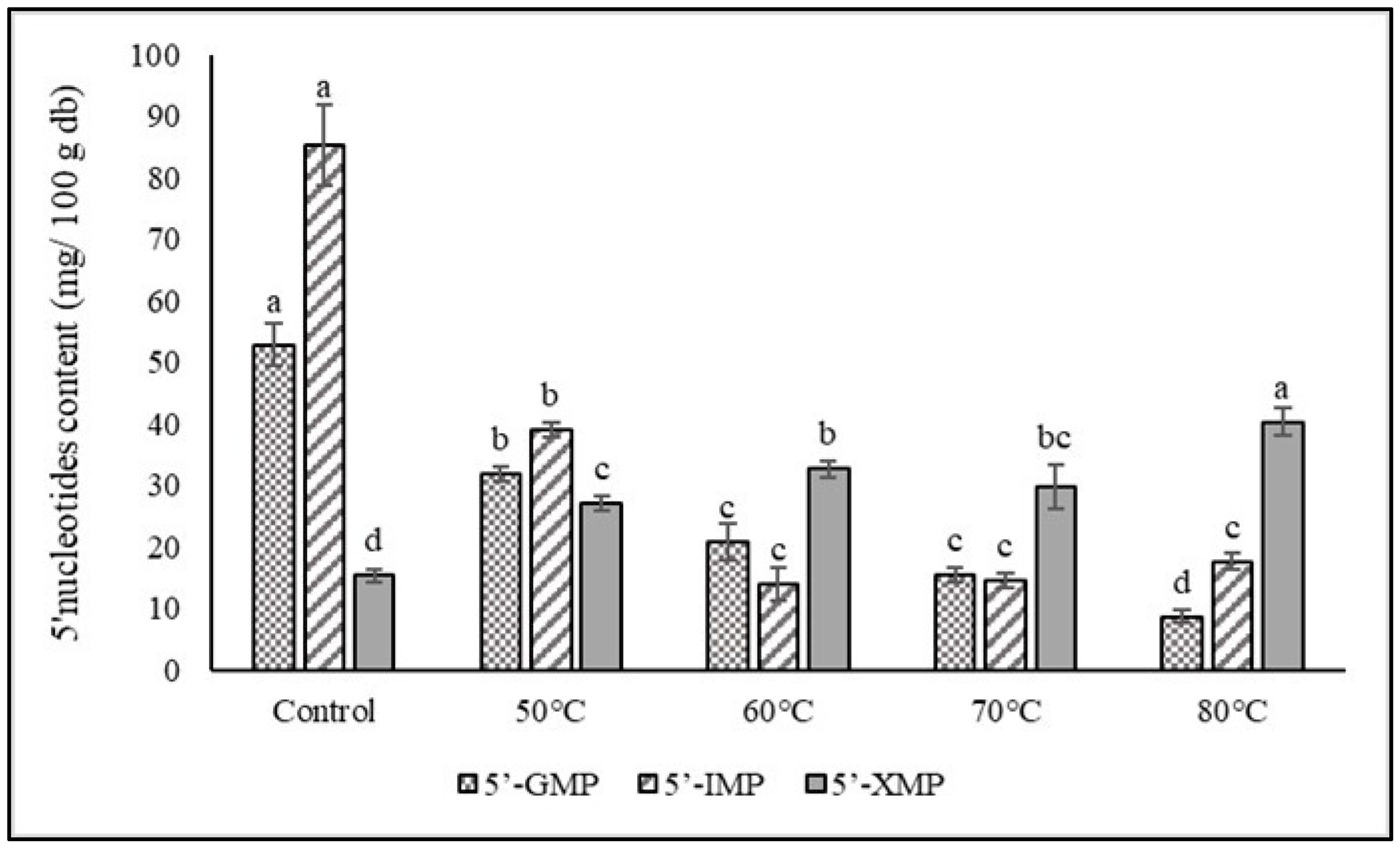
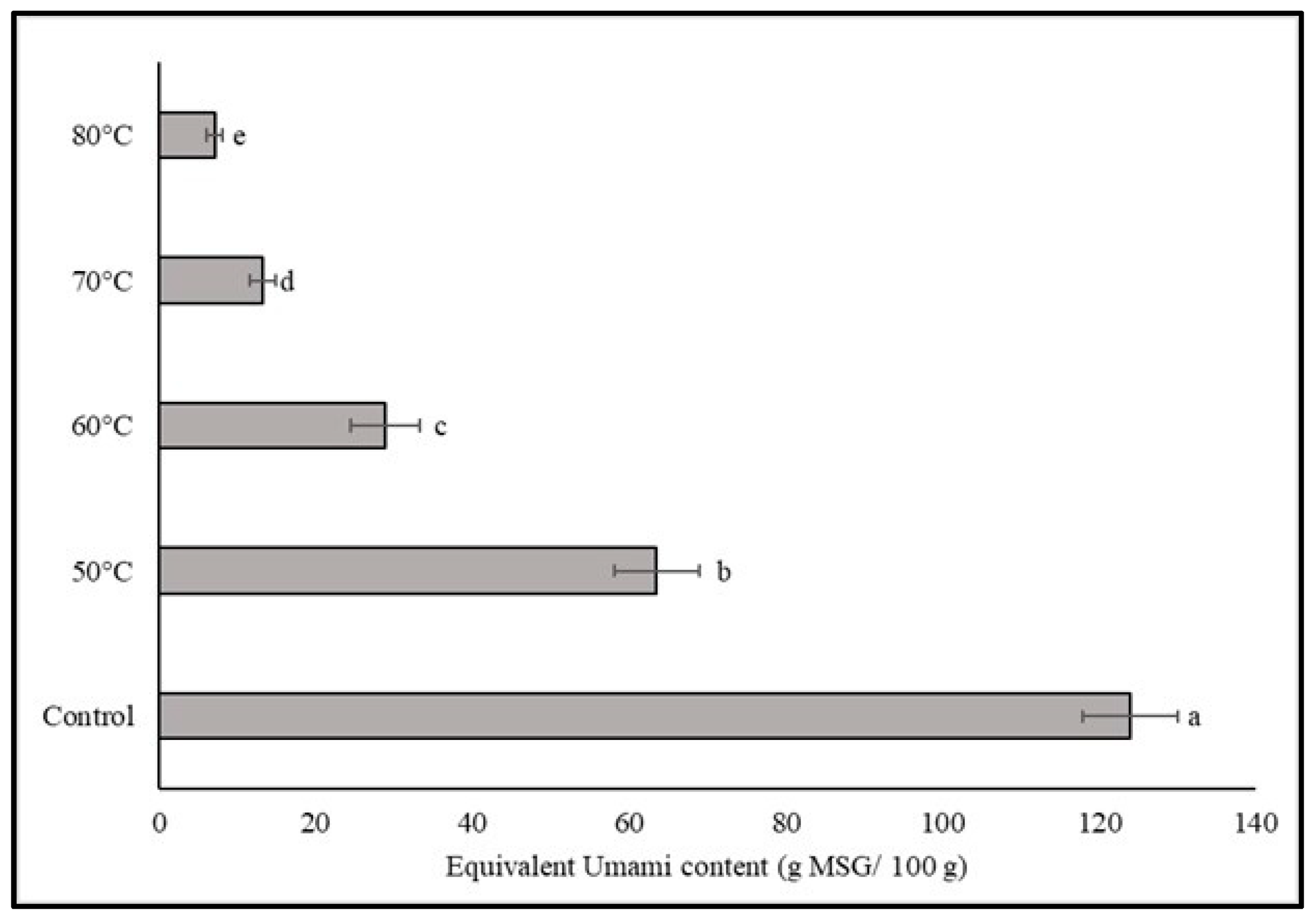
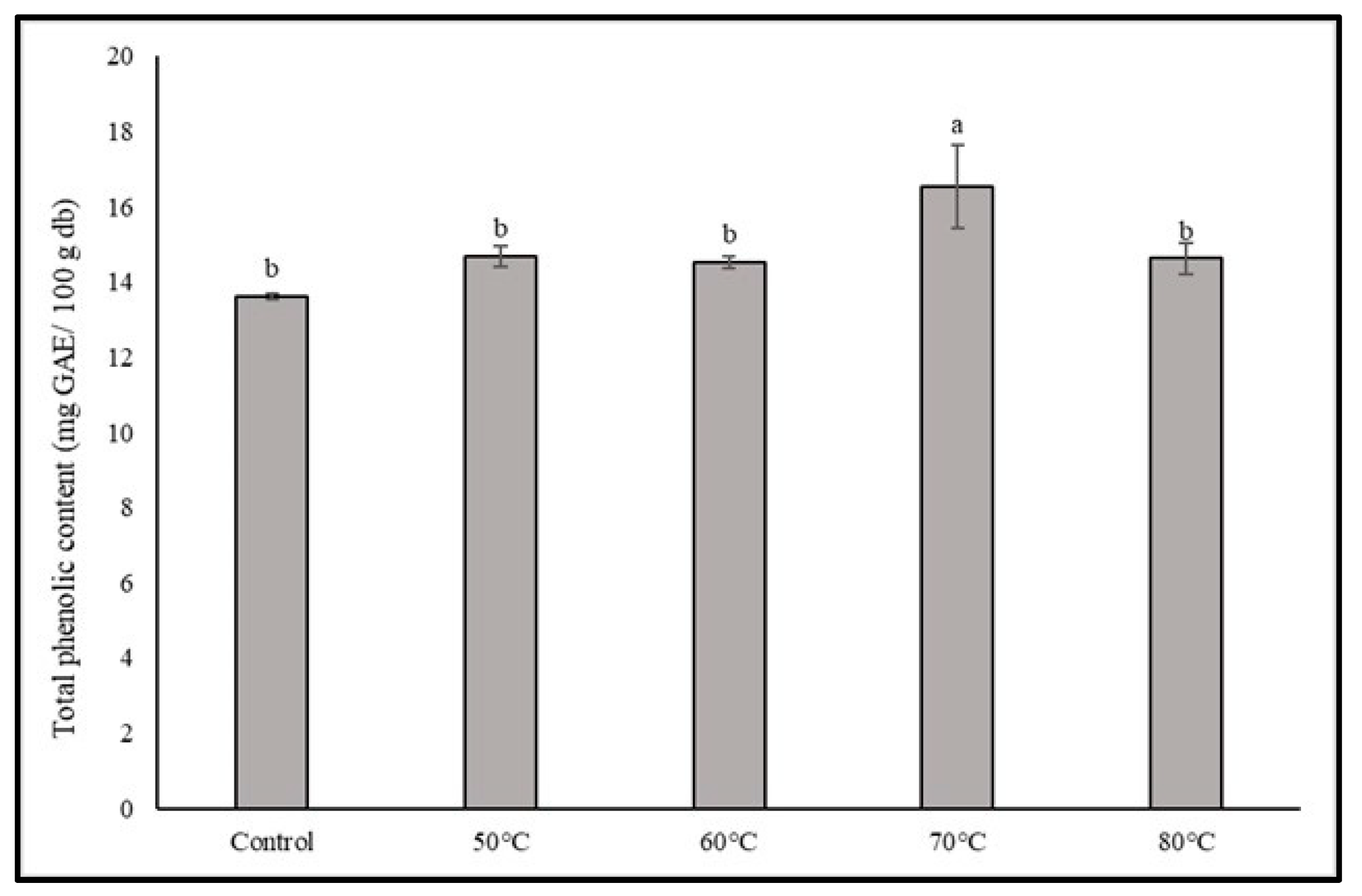
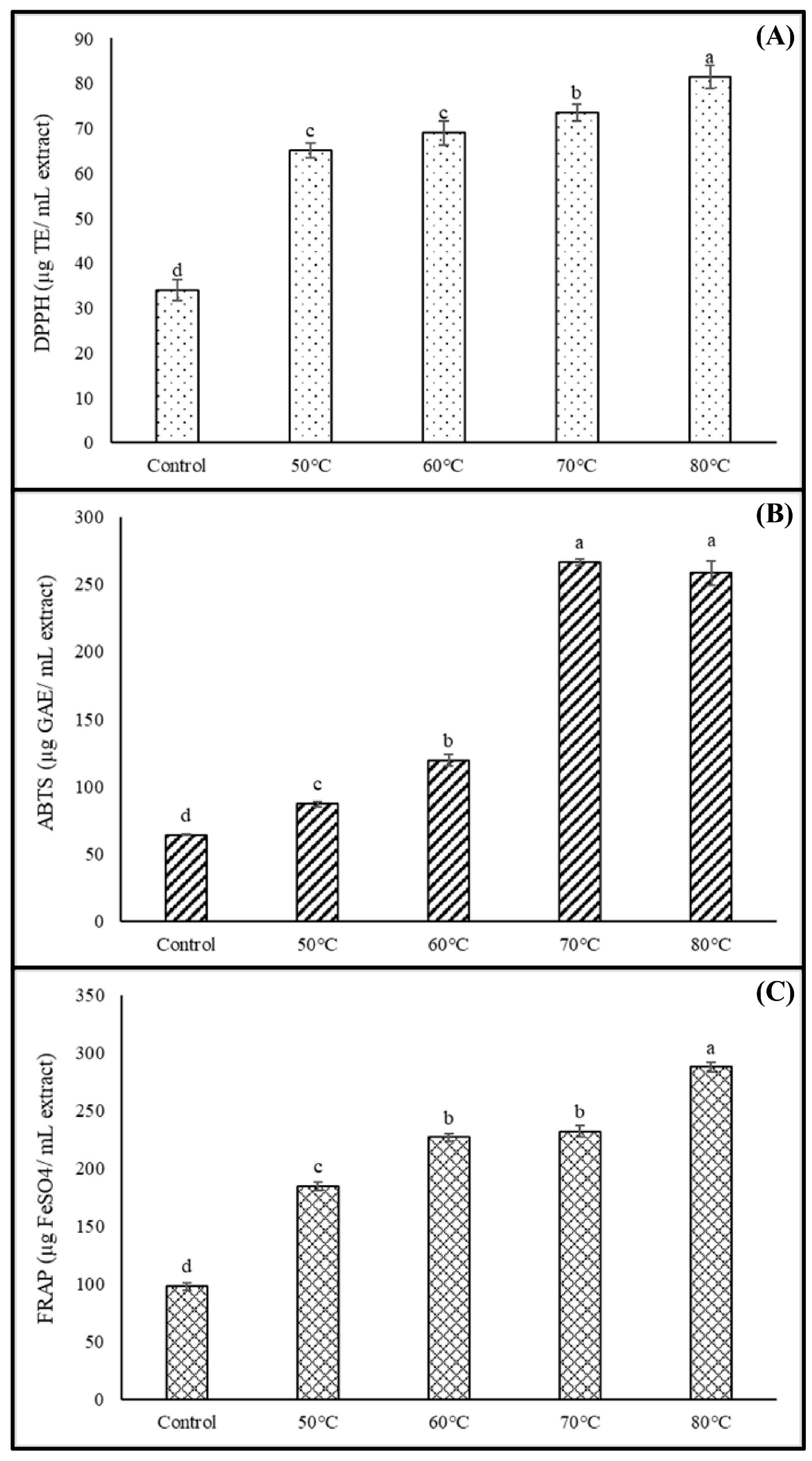
| Aging Condition | Control | 50 °C | 60 °C | 70 °C | 80 °C | |
|---|---|---|---|---|---|---|
| Moisture content (%) | 8.64 ± 1.95 c | 19.76 ± 1.88 a | 19.69 ± 0.30 a | 14.37 ± 0.21 b | 15.09 ± 0.13 b | |
| aw | 0.34 ± 0.05 c | 0.69 ± 0.01 a | 0.68 ± 0.02 a | 0.61 ± 0.01 b | 0.62 ± 0.01 b | |
| Color values | L * | 55.70 ± 2.60 a | 48.53 ± 1.51 b | 45.46 ± 1.84 cd | 46.42 ± 0.82 c | 44.54 ± 1.36 d |
| C * | 13.92 ± 1.03 a | 12.75 ± 1.05 b | 12.01 ± 0.67 c | 10.74 ± 0.34 d | 8.72 ± 0.46 e | |
| h | 52.41 ± 2.82 a | 49.55 ± 2.00 b | 43.87 ± 1.44 c | 42.51 ± 0.81 c | 38.12 ± 1.68 d | |
| Amino Acid (mg/100 g db) | Aging Condition (°C) | ||||
|---|---|---|---|---|---|
| Control | 50 | 60 | 70 | 80 | |
| Asp ns | 61.48 ± 18.98 | 51.05 ± 4.87 | 45.77 ± 2.04 | 39.51 ± 2.19 | 41.92 ± 5.21 |
| Thr | 127.81 ± 9.17 a | 90.19 ± 2.66 b | 61.64 ± 2.18 c | 38.20 ± 7.34 d | 43.11 ± 4.69 d |
| Ser | 98.85 ± 20.30 a | 111.60 ± 10.71 a | 90.81 ± 4.21 ab | 68.91 ± 3.94 bc | 54.40 ± 6.64 c |
| Glu | 467.42 ± 51.76 a | 399.08 ± 30.89 a | 283.32 ± 7.78 b | 155.25 ± 6.00 c | 90.29 ± 9.49 c |
| Pro | 45.83 ± 6.08 a | 42.67 ± 0.56 ab | 36.88 ± 1.61 bc | 30.29 ± 0.73 cd | 24.66 ± 1.22 d |
| Gly | 84.41 ± 12.99 a | 62.61 ± 2.63 b | 47.85 ± 0.25 bc | 37.57 ± 0.59 c | 34.43 ± 2.76 c |
| Ala + Cys ns | 211.16 ± 34.33 | 222.06 ± 9.44 | 210.74 ± 0.66 | 193.02 ± 0.03 | 207.56 ± 12.28 |
| Val | 330.13 ± 28.62 ab | 354.37 ± 8.88 a | 337.35 ± 3.96 ab | 295.49 ± 16.65 bc | 286.14 ± 10.70 c |
| Met ns | 8.42 ± 2.11 | 7.49 ± 1.45 | 8.18 ± 0.27 | 6.31 ± 0.61 | 4.01 ± 0.62 |
| Ile | ND | ND | ND | ND | ND |
| Leu | ND | ND | ND | ND | ND |
| Tyr | ND | ND | ND | ND | ND |
| Phe ns | 152.51 ± 32.20 | 158.96 ± 13.03 | 157.89 ± 4.05 | 151.09 ± 4.11 | 135.12 ± 15.36 |
| His | 31.46 ± 1.94 a | 14.59 ± 0.93 b | 11.11 ± 1.30 c | 9.28 ± 1.18 c | 11.14 ± 0.46 c |
| Lys ns | 197.15 ± 11.74 | 174.97 ± 29.04 | 152.66 ± 62.33 | 120.06 ± 61.55 | 143.10 ± 1.11 |
| Arg | ND | ND | ND | ND | ND |
| Phenolic Compound (µg/100 g db) | Aging Condition | ||||
|---|---|---|---|---|---|
| Control | 50 °C | 60 °C | 70 °C | 80 °C | |
| Gallic acid | ND | ND | ND | ND | ND |
| Theobromine | 38.79 ± 5.46 c | 49.60 ± 0.85 b | 51.18 ± 4.35 b | 55.65 ± 1.56 b | 74.80 ± 0.11 a |
| Protocatechuic acid | ND | ND | ND | ND | ND |
| p-Hydroxybenzoic acid | 56.84 ± 2.76 a | 47.48 ± 3.44 b | 50.21 ± 1.78 b | 49.18 ± 1.95 b | 21.97 ± 0.39 c |
| Catechin | ND | ND | ND | ND | ND |
| Chlorogenic acid | 36.91 ± 0.14 a | 21.19 ± 5.28 b | 22.79 ± 1.09 b | 21.06 ± 0.68 b | 9.34 ± 0.78 c |
| Caffeine | ND | ND | ND | ND | ND |
| Vanillic acid | 50.87 ± 0.90 d | 62.70 ± 3.37 c | 73.05 ± 4.64 b | 90.15 ± 1.75 a | 65.72 ± 3.25 c |
| Caffeic acid | ND | ND | ND | ND | ND |
| Syringic acid | 8.70 ± 0.77 c | 10.04 ± 0.83 b | 11.14 ± 0.36 a | 11.55 ± 0.05 a | 8.34 ± 0.49 c |
| Epicatechin | ND | ND | ND | ND | ND |
| Vanillin | ND | ND | ND | ND | ND |
| p-Coumaric acid | ND | ND | ND | ND | ND |
| Ferulic acid | ND | ND | ND | ND | ND |
| Sinapic acid | ND | ND | ND | ND | ND |
| Rutin | ND | ND | ND | ND | ND |
| Myricetin | ND | ND | ND | ND | ND |
| Quercetin | ND | ND | ND | ND | ND |
| Trans-cinnamic acid | TR | 14.05 ± 1.05 a | 14.49 ± 1.94 a | 13.97 ± 0.11 a | 11.11 ± 0.14 b |
Disclaimer/Publisher’s Note: The statements, opinions and data contained in all publications are solely those of the individual author(s) and contributor(s) and not of MDPI and/or the editor(s). MDPI and/or the editor(s) disclaim responsibility for any injury to people or property resulting from any ideas, methods, instructions or products referred to in the content. |
© 2023 by the authors. Licensee MDPI, Basel, Switzerland. This article is an open access article distributed under the terms and conditions of the Creative Commons Attribution (CC BY) license (https://creativecommons.org/licenses/by/4.0/).
Share and Cite
Chaipoot, S.; Wiriyacharee, P.; Phongphisutthinant, R.; Buadoktoom, S.; Srisuwun, A.; Somjai, C.; Srinuanpan, S. Changes in Physicochemical Characteristics and Antioxidant Activities of Dried Shiitake Mushroom in Dry-Moist-Heat Aging Process. Foods 2023, 12, 2714. https://doi.org/10.3390/foods12142714
Chaipoot S, Wiriyacharee P, Phongphisutthinant R, Buadoktoom S, Srisuwun A, Somjai C, Srinuanpan S. Changes in Physicochemical Characteristics and Antioxidant Activities of Dried Shiitake Mushroom in Dry-Moist-Heat Aging Process. Foods. 2023; 12(14):2714. https://doi.org/10.3390/foods12142714
Chicago/Turabian StyleChaipoot, Supakit, Pairote Wiriyacharee, Rewat Phongphisutthinant, Srirana Buadoktoom, Aungkana Srisuwun, Chalermkwan Somjai, and Sirasit Srinuanpan. 2023. "Changes in Physicochemical Characteristics and Antioxidant Activities of Dried Shiitake Mushroom in Dry-Moist-Heat Aging Process" Foods 12, no. 14: 2714. https://doi.org/10.3390/foods12142714
APA StyleChaipoot, S., Wiriyacharee, P., Phongphisutthinant, R., Buadoktoom, S., Srisuwun, A., Somjai, C., & Srinuanpan, S. (2023). Changes in Physicochemical Characteristics and Antioxidant Activities of Dried Shiitake Mushroom in Dry-Moist-Heat Aging Process. Foods, 12(14), 2714. https://doi.org/10.3390/foods12142714







